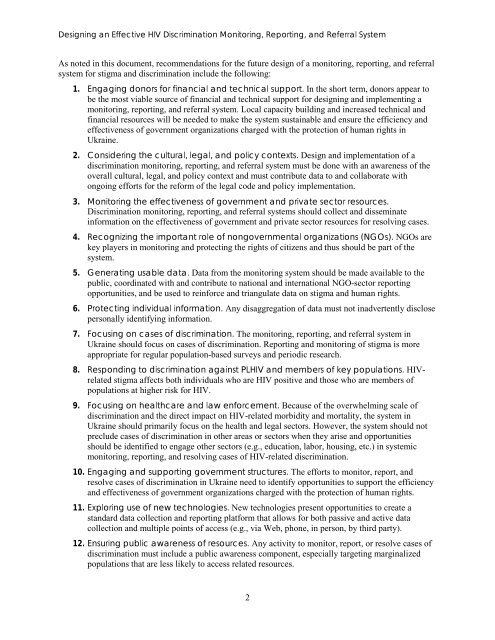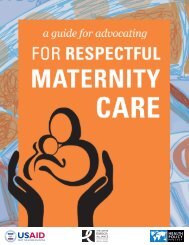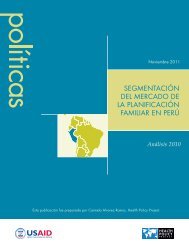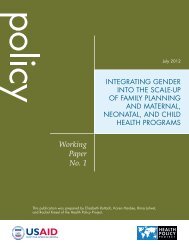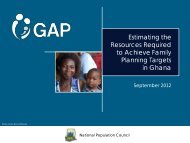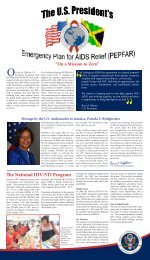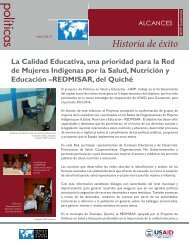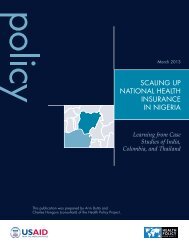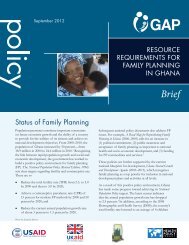English Version - Health Policy Project
English Version - Health Policy Project
English Version - Health Policy Project
Create successful ePaper yourself
Turn your PDF publications into a flip-book with our unique Google optimized e-Paper software.
Designing an Effective HIV Discrimination Monitoring, Reporting, and Referral System<br />
As noted in this document, recommendations for the future design of a monitoring, reporting, and referral<br />
system for stigma and discrimination include the following:<br />
1. Engaging donors for financial and technical support. In the short term, donors appear to<br />
be the most viable source of financial and technical support for designing and implementing a<br />
monitoring, reporting, and referral system. Local capacity building and increased technical and<br />
financial resources will be needed to make the system sustainable and ensure the efficiency and<br />
effectiveness of government organizations charged with the protection of human rights in<br />
Ukraine.<br />
2. Considering the cultural, legal, and policy contexts. Design and implementation of a<br />
discrimination monitoring, reporting, and referral system must be done with an awareness of the<br />
overall cultural, legal, and policy context and must contribute data to and collaborate with<br />
ongoing efforts for the reform of the legal code and policy implementation.<br />
3. Monitoring the effectiveness of government and private sector resources.<br />
Discrimination monitoring, reporting, and referral systems should collect and disseminate<br />
information on the effectiveness of government and private sector resources for resolving cases.<br />
4. Recognizing the important role of nongovernmental organizations (NGOs). NGOs are<br />
key players in monitoring and protecting the rights of citizens and thus should be part of the<br />
system.<br />
5. Generating usable data. Data from the monitoring system should be made available to the<br />
public, coordinated with and contribute to national and international NGO-sector reporting<br />
opportunities, and be used to reinforce and triangulate data on stigma and human rights.<br />
6. Protecting individual information. Any disaggregation of data must not inadvertently disclose<br />
personally identifying information.<br />
7. Focusing on cases of discrimination. The monitoring, reporting, and referral system in<br />
Ukraine should focus on cases of discrimination. Reporting and monitoring of stigma is more<br />
appropriate for regular population-based surveys and periodic research.<br />
8. Responding to discrimination against PLHIV and members of key populations. HIVrelated<br />
stigma affects both individuals who are HIV positive and those who are members of<br />
populations at higher risk for HIV.<br />
9. Focusing on healthcare and law enforcement. Because of the overwhelming scale of<br />
discrimination and the direct impact on HIV-related morbidity and mortality, the system in<br />
Ukraine should primarily focus on the health and legal sectors. However, the system should not<br />
preclude cases of discrimination in other areas or sectors when they arise and opportunities<br />
should be identified to engage other sectors (e.g., education, labor, housing, etc.) in systemic<br />
monitoring, reporting, and resolving cases of HIV-related discrimination.<br />
10. Engaging and supporting government structures. The efforts to monitor, report, and<br />
resolve cases of discrimination in Ukraine need to identify opportunities to support the efficiency<br />
and effectiveness of government organizations charged with the protection of human rights.<br />
11. Exploring use of new technologies. New technologies present opportunities to create a<br />
standard data collection and reporting platform that allows for both passive and active data<br />
collection and multiple points of access (e.g., via Web, phone, in person, by third party).<br />
12. Ensuring public awareness of resources. Any activity to monitor, report, or resolve cases of<br />
discrimination must include a public awareness component, especially targeting marginalized<br />
populations that are less likely to access related resources.<br />
2


